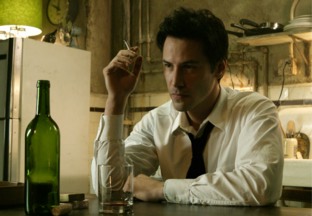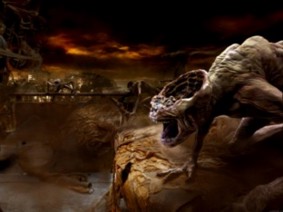"I
don't really think that the studio understands this
movie completely…" |
Director Francis Lawrence interviewed in issue 322 of Starburst |
That
can only be a good thing, no?
Keanu
Reeves slipped on to my radar playing a Californian airhead
with delusions of world peace via air-guitar licks. Inside
a time travelling phone booth (an idea blatantly stolen
from a TV series as old as I am about to make a big comeback
this Easter) he and his partner went back to wonderfully
funny moments in the past. Destined by some future council
to be very important to the peace of the world, the two
boys needed real historical help with their school history
presentation. Reeves fitted Ted 'Theodore' Logan like made
to measure mittens. It was initially difficult to imagine
the actor in any other role, so convincing was he at empty
headedness, laid back physicality and smiley optimism. The
movie actually affected me (I was working in the US at the
time) and could not stop 'dude'ing this and 'dude'ing that
for weeks. It only took the turtle character of 'Crush'
in Finding Nemo seconds to take me straight
back to California in 1989 where I infuriated my house mates
with my woeful impressions of Los Angeles' 'valley speak'.
There was something very sweet about this pair (Bill and
Ted for the uninitiated) and the sequel in which Death joins
them while they try to save the world (again) is also a
hoot. You have to love an American movie aimed at teens
that riffs off von Sydow's playing chess for his very soul
against the Grim Reaper in The Seventh Seal.
In Bill and Ted's case, they get to choose the game.
For their immortal souls, Bill and Ted take on Death at
(oh joy) Twister™!

After
a string of movies that required more acting muscle than
he had brought to bear, Reeves then surfed a massive wave
in 1999 (my God, was it really six years ago?) and earned
his place as the bona fide action star in the movie that
rewrote the action movie rules. He looked good. He looked
great. He suited black well, was whippet thin and his angular
physicality and lithe movement played very well in The
Matrix's world of PVC, faux digital dopplegangers
and designer shades. All he had to do was act mildly confused
and try to beat the shit out of Lawrence Fishburne. Yes,
there was all that special effects work but acting talent?
It's been written, not least in this site's pages, that
movie stars do not have to be great actors so on that level,
Keanu Reeves is a damn fine… movie star. Yes, his
actual acting is not up there with, say a Nicole Kidman
or the iconic seventies and eighties' grand slam performances
of De Niro nor is it chasing the coat tails of Tom Hanks
too hard.
But
can you see how convincing Hanks would be as The
Matrix's Neo, even in his younger days? Tchah.
No. Keanu 'fits' movies that call out for his specific brand
of laconic, iconic cool and I'm happy to say (with some
reservations), that Constantine fits him
very snugly indeed. I will not stop to bemoan what was lost
in translation. It's lost and there's nothing die hard fans
of the very blond Brit who is the original John Constantine
in the Hellblazer comic books can do or say to make it ain't
so. If you spend a great deal of money on a movie, you have
to 'streamline' the character and concept to stand a chance
of making back what, in essence, is a huge gamble on a prototype.
To stand a chance (goes the blockbuster mentality) of making
a sizeable return on a sizeable investment, you need your
elements in place. A northern accented Brit was not going
to cut it with Joe Schmoe in Kansas (with apologies to Joe
himself, nothing personal). So Keanu slips on Constantine's Reservoir Dogs' cozzie and lo and behold,
a man with issues and you actually believe it.
Playing
the cool card is not hard for Keanu. After a puzzling (but
intriguing) opening involving a few south of the border
labourers and a significant blade we get to see our chain-smoking
hero despatch a demon, a full blown CG exorcism which, I
admit, was pretty exciting. I was impressed with the narrative
unveiling itself very assuredly despite the number of different
threads it begins with (at least five sub-plot/main plot
strands start out with very little explanation - just the
way I like it).
John
Constantine is a troubled man. He has lung cancer (the aggressive
kind - as opposed to the pussy cat kind?) and is either
sucking in smoke or exhaling blood all throughout the movie.
He is also aware of the 'deal' struck between God and Satan
- a balance between the forces of good and evil. His gift
and curse is that he is able to 'see' those demons on Earth
that are half way between the different planes of existence.
Seeing these demons as a child prompted a suicide attempt
that literally gave him a way to hell. In a throwaway conversation
with what turns out to be the angel Gabriel (played beguilingly
by Tilda Swinton and we love the wings), the basis on which
the movie is built is sketched in. Apparently Constantine
does not need to believe in God and Satan because he knows
them to exist (a nice twist on the need for faith based
characters in a religious context). He also knows that he
will be dead within a year and will go back to hell; suicides
(according to the ludicrous Catholic doctrine) are destined
for hell, no questions asked. Is there work he can do on
Earth before his descent to appease God and get him strumming
amidst the clouds? My first thought upon hearing of his
illness was how does a character realistically get better
from lung cancer? After all, this is a Hollywood movie and
has potential franchise smeared in pixels all over it. This
was answered at the end of the movie in one of those moments
that may (just may) make sense to some overpaid screenwriter
with an exec breathing hard down his/her neck but in hindsight,
it's a cheap and unworthy gimmick to reset the hero's body
back to a 'franchisable' state.

Constantine
has a sidekick, a demon hunting wannabe, who is employed
as his driver. Cast as a very young man, his purpose seems
only to be kept in the dark, a non-character who serves
no useful function. Constantine also has his 'Giles', a
man who knows things that would normally have him committed
and can point our hero in the right direction. Hollywood
movie narrative commandments mean that he won't last the
120 minutes but it is those who see the truth and dare to
tell that end up the worst served in Constantine's world.
Isobel, a mental patient who has been seeing demons since
she was a child, throws herself off a roof. Her twin sister,
Angela (both parts played by The Mummy's
Rachel Weisz) is a cop in denial of her own abilities to
see demons. She teams up with Keanu to find out 'the truth'
about the suicide and along the way we are treated to vistas
of hell as Neo (oops, sorry, John) drops in almost as casually
as a wave of a hand. Hell in Constantine is essentially L.A. (OK so far) overlaid with a layer of
sulphur, a 'ring-on-Frodo's-Finger' heat haze world where
John Constantine is the only natural creature. CG demons
crawl and writhe in torment nodding to Heironymous Bosch
very vigorously. The Hell scenes are quite atmospheric and
it's clear that these pivotal sequences had a lot of thought
layered into them. It's only the filmmakers' version of
heaven that's truly risible. Briefly glimpsed at the
climax, there's a building or two but mostly God's realm
is a cloudy sky and bright light. It's an absurd cliché,
a shame given the thought gone into 'down under'.
Since Buffy, the demon on Earth has been well
represented. Each Hell demon in Constantine is a wraith of grey, naked flesh pockmarked and smeared
with (one assumes) burn marks. They are ugly as sin (now
that phrase at last makes sense) and of course, anything
that ugly in L.A. (or Hell A.) must be evil. Noteworthy
though is the only moment a CG creation has made me jump
even though it was probably the loud shriek on the soundtrack.
The Earth-based demons are dressed in skin, scoured off
them by Holy Water (is there nothing that stuff can't do?)
and seem to have no special powers as even Keanu can beat
the shit out of them sans wires and sans Kung Fu speed-learned
into his cortex (and with a nasty smoker's cough).
The
reason everyone in the know is so touchy about the balance
between good and evil being disrupted takes us back to the
Mexican labourer at the start of the movie. The blade he
finds - which imbues him with starling superhuman ability
- is in fact the spear responsible for the actual death
of Christ. It's going to be used nefariously (as all spears
that killed Christ must be) and bring forth Satan's spawn.
The twists at the climax, which I will not reveal, are nothing
truly surprising but the justification of the principal
antagonist's actions seem to be 'the worse I make things,
the better people have to be to face up to them therefore
I am making people better…' Now that bullshit may
work in Cloud land but from where Constantine sits (bleeding),
it's a different story and before you know it Satan himself
has turned up (seems he's looking forward to tormenting
Keanu) and not only is he all dressed in white (all the
good guys wear black so he has to be sartorially opposite)
it turns out it's Peter (the quiet murderous one in Fargo)
Stormare! It's a casting coup and almost works (giving the
head demon a human form and that particular one at that).
Needless
to say, Constantine upsets His plans (what? Is it only God
who gets the 'start-with-a-capital' treatment?), earns his
redemption and life returns to normal sans infected lungs.
If only it were that easy. Constantine is a fair film, not
great, not terrible but fair. It's inventive, visually captivating
and performed with some gusto. But I can't see it going
the franchise distance, well, not in the US. There are too
many sandwiched between the coasts who believe in all this
stuff. After all it's only John Constantine who knows it's all true…
|